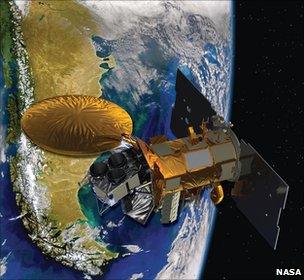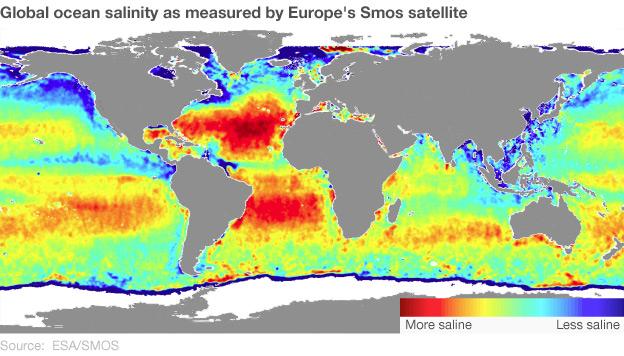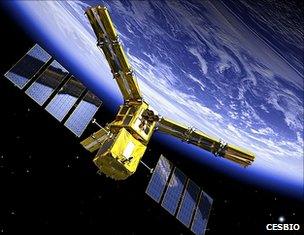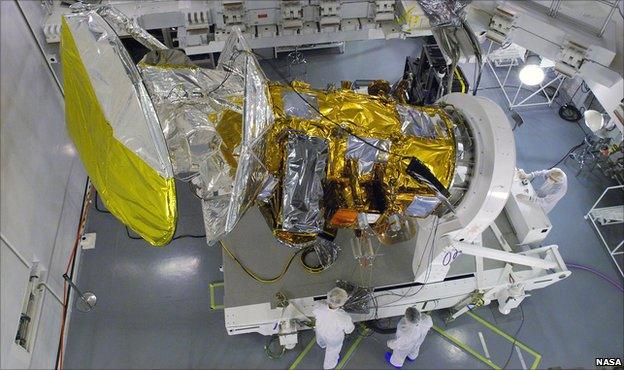Aquarius 'salt mapper' satellite goes into orbit
- Published

Nasa studies many ocean properties from orbit but salinity has been a major omission
A satellite that will map the saltiness of seawater has gone in orbit.
Data from the Aquarius/SAC-D spacecraft will help scientists understand better the processes that drive ocean circulation and the movement of freshwater around the planet.
A Delta rocket carried the satellite aloft, launching from California, US, at 0720 local time (1420 GMT).
The mission is led by the space agencies of America and Argentina (Nasa and Conae).
There are inputs also from Brazil, Canada, France and Italy.
Scientists have been able to measure ocean salinity for decades by lowering instruments from ships or by deploying robotic floats, but the technology to sense this property from orbit is a recent innovation.
Salinity is of interest to researchers because it is both a determinant of ocean behaviour and a tool to diagnose what might be happening in the climate system.
Aquarius carries three high-precision radio receivers that will record the natural microwave emissions coming up off the water's surface. These emissions vary with the electrical conductivity of the water - a property directly related to how much dissolved salt it is carrying.
Together with temperature, salinity will define water density, and density and wind are the wheels of ocean circulation - the means by which Earth moves much of the energy it receives from the Sun around the globe.
By monitoring changes in the amount of dissolved salts at the surface, scientists can see also where water is being evaporated and precipitated.
Evaporation at the surface increases salinity by leaving behind salts as the water moves into the atmosphere. When it rains, the surface is diluted and salinity drops. In this sense, the amount of salt present is a tracer for the global water cycle. It is thought something like 80% of this cycle - which moves fresh water from the ocean to the atmosphere, to the land, and back to the ocean again - occurs out over the sea.
Eric Lindstrom, an Aquarius programme scientist at Nasa, said the new satellite would fill an important gap in the remote sensing observations made by the American agency.
"In the Earth science division of Nasa, we have 13 missions in orbit right now and about half of them measure ocean quantities - we get sea-surface temperature, ocean winds, sea level, ocean colour, and the changing mass of the oceans," he explained.
"A key missing piece that's really in demand by the ocean science community is ocean salinity."
Getting this data from orbit is not a simple matter, however.
The range of salinity that can be measured is a small one - generally between about 32 and 37 parts per thousand out over the open ocean.

Europe has already begun to make space-based maps of salinity; soon, scientists will have double the data and an even better view of the subject
"Our goal is to retrieve salinity at 0.2 parts per thousand," said Aquarius Principal Investigator Gary Lagerloef of Earth & Space Research in Seattle. "That's the equivalent concentration if you were to take a dash of salt about the same as one-eighth of teaspoon and put it in a gallon of water.
That works out to about one millilitre of salt in six litres of water.

The Delta is seen climbing high into the sky above the Vandenberg Air Force Base
"That's the amount of salinity change that Aquarius will be able to observe from month to month over any part of the ocean."
The Nasa-Conae spacecraft will not be the first ocean salinity mission in orbit. Europe already has a satellite in operation called Smos. This was launched in 2009 and produced the first-ever global maps of salinity built from space data.
Before it achieved this milestone, Smos had a torrid time coping with interference from radars, TV and radio links, and even wi-fi networks whose emissions were bleeding across the microwave signal. But Gary Lagerloef says the different radiometer design on Aquarius should fare much better, and he looks forward to getting double the data.
"The two teams have worked in parallel for a decade now, developing their respective missions; we have shared information and it has been a strong cooperative effort," he told BBC News.
"Once we have both of these missions in orbit, we will compare results - we'll inter-calibrate them, we'll combine the measurements together. We'll do all we can to provide the best information about ocean surface salinity to the scientific community."

Europe's Smos spacecraft went into orbit in 2009
The Aquarius/SAC-D spacecraft weighed about 1.3 tonnes at lift-off.
Its radiometers are complemented by a radar instrument which studies how wind is roughening the sea surface and potentially skewing the microwave signal. All this equipment is provided by Nasa.
Conae has been responsible for the spacecraft bus, or chassis. This bus also hosts seven instruments - most built by the Argentinians.
These systems will be making a wide range of observations - from the imaging of urban lighting and monitoring forest fires to looking for space debris and making measurements of sea-ice.
Nasa had been under some pressure with this launch. Its previous attempt to get an Earth observation spacecraft into orbit ended in failure when the carrier rocket malfunctioned. The Glory satellite fell into the Southern Ocean off Antarctica and was destroyed.

Nasa has provided the ocean salinity instrument; Conae has provided the main satellite bus and a number of other instruments. The spacecraft will circle the Earth, travelling from pole to pole
- Published4 March 2011
- Published30 June 2010